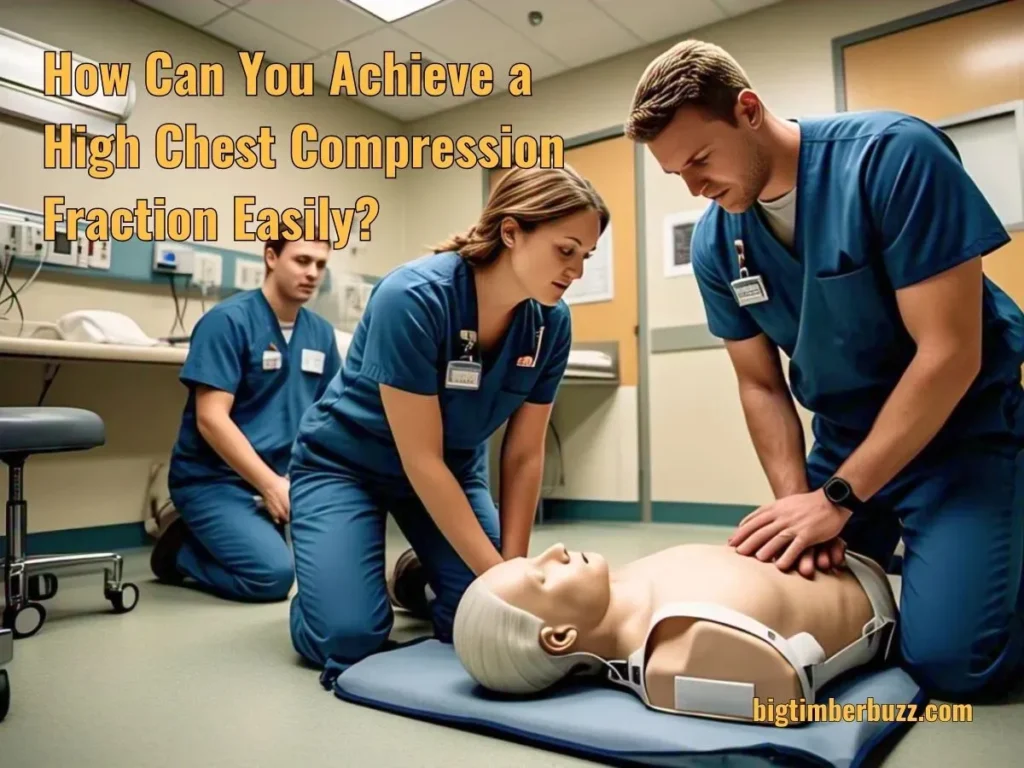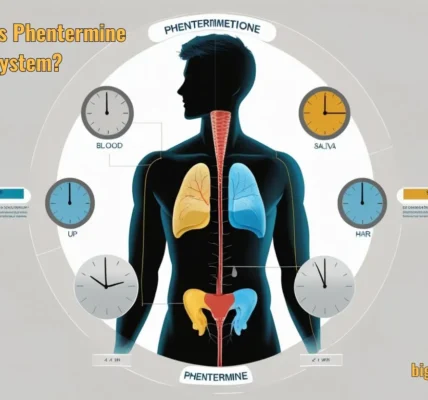Introduction
So, How Can You Achieve a High Chest Compression Fraction? In a loved one’s collapse, every moment counts.
A high CCF (proportion of CPR time based only on chest compressions) can double the chance of survival, and the AHA recommends over 80% for optimum performance in CPR.
Inadequate compression technique or interruptions of chest compressions often decrease CCF and compromise lives. This guide provides expert-approved CPR training tips, tactics, and tools to help you perform high-quality CPR.
You’ll learn lifesaving techniques whether you are a nurse, first responder, or layperson. Ready to make a difference? Let’s dive in!
Understanding “How Can You Achieve a High Chest Compression Fraction?”

Chest compression fraction is a measure of the proportion of CPR time that compressions are administered and is calculated as a percentage using the chest compression fraction formula: (compression time / total time of resuscitation) * 100.
Blood flow is maintained at a stable level by ensuring a high chest compression fraction (>80%), which in turn increases survival rates.
A 2021 Resuscitation study found that an increase in cardiac contractility (CCF) leads to a successful outcome (PMC9006719). What is the most important factor of chest compression fraction? Cycles such as pulse checks or ventilations decrease CCF.
According to the AHA’s 2025 recommendations, reducing pauses is vital to achieving a high CCF. The life-saving skills stand on your knowledge of the CCF.
Top Techniques to “How Can You Achieve a High Chest Compression Fraction”
Learning the technique “How Can You Achieve a High Chest Compression Fraction” begins with proper chest compressions. Follow these four steps to increase your CCF and improve the quality of CPR:
- Cross Hands Properly: Position one hand’s heel over the lower sternum, with the other hand resting over that hand’s fingers. Correct positioning for compressions.
- Keep Steady Beat: Aim to perform CPR at a rate of 100–120 compressions per minute, like “Stayin’ Alive” by the Bee Gees. Consistency drives high CCF.
- Chest Compression Techniques on a Manikin Minimise pauses: any interruptions, regardless of how brief, including ventilations, pulse checks, should not exceed ten seconds.
- Push deep enough: compress the chest by 5-6 centimetres for adults with full chest recoil. Adequate chest compression depth ensures there is an outflow of blood.
Avoid These Mistakes:
- Long pauses: Any pause that is longer than ten seconds will decrease the CCF below 60 per cent.
- Shallow push: Any shallow push will not only reduce the efficiency of the blood flow.
- Incorrect positioning: chest compressions that are not centred will lower the overall CCF.
Practice on a manikin to refine your skills and gain confidence. A steady rhythm, coupled with brief or no pauses, is crucial to excellent chest compressions.
Tools to Boost Chest Compression Fraction
Technology can help you secure an excellent chest compression fraction. CPR feedback devices and metronomes are available during training and in emergencies to help you maintain a steady rhythm.
- CPR feedback devices, such as ZOLL’s CPR Dashboard and Laerdal’s Q-CPR, provide real-time feedback on compression rate and depth during cardiopulmonary resuscitation (CPR). They will give an audible warning if you exceed 100–120 BPM in compressions or 5-6 cm in depth, thus increasing the CCF by 15 % in 2023.
- Metronome apps: 100-120 BPM apps like “CPR Metronome” or “PulsePoint” to hold a precise rhythm.
- Implications of tools: While you may develop muscle memory and thus perform chest compressions accurately, restricted usage of tools might cause low CCF throughout performance.
Tool Comparison:
| Tool | Features | Cost | AHA-Approved? |
| ZOLL CPR Dashboard | Rate/depth feedback, visual alerts | $500+ | Yes |
| Laerdal Q-CPR | Audio cues, depth tracking | $400+ | Yes |
| CPR Metronome App | 100–120 BPM audio, portable | Free–$5 | N/A |
Use a free metronome app or get CPR feedback devices for professional chest compression training.
Special Considerations for Different Scenarios
Methods to achieve a high CCF are context-specific. Here are your go-tos for making them work:
- Infant & Child CPR: Two fingers for infants (4 cm), one hand for children (5 cm). pediatric cpr ccf CCF for pediatric cpr = Chest compression fraction for pediatric CPR. They still do compressions at rates greater than 80%.
- Hospital: Collaborate with a team to maintain pauses under 10 seconds. CPR outcomes in hospitals frequently utilise defibrillators with real-time feedback to ensure CCF.
- Civilian CPR: Emphasis on compression-only CPR to minimise interruption and maintain a high chest compression fraction without ventilations.
Case Study: In 2024, using real-time feedback, a Chicago ER team achieved a 92% CCF to save a 50-year-old patient. These are strategies to promote high-quality CPR across all settings.
Training and Certification for High CCF
Formal CPR training is necessary to ensure a high chest compression fraction.
Here’s how to excel:
- Take a Class: AHA and Red Cross both offer online and in-person CPR certification classes that are CCF-oriented. AHA’s HeartCode CPR (about $30, 2–3 hours) is about learning the technique for chest compressions.
- Benefits of Certification: Verifies for nurses, teachers, or laypersons. Clinically, it is confidence-building to maximise the chest compression fraction in emergencies.
- Clinical Teaching Points: Practice chest compression fraction certified on manikins with feedback. Monthly, it’s good to go to keep the reflexes sharp.
FAQ:
- What can I do to become certified in CPR? Take AHA or Red Cross courses online or at a local training location.
- What really impacts chest compression fraction? CCF is affected by time delays, depth, and rhythm.
- How often should I train? Monthly to stay sharp.
Get some CPR training and become a lifesaver. Still Quries “How Can You Achieve a High Chest Compression Fraction”?
Common Mistakes That Lower Chest Compression Fraction
Some pitfalls disturb the performance of CPR to accomplish a high chest compression fraction. Common mistakes can result in a CCF rate below this 80% target, thereby lowering the odds of survival.
Here are the key errors and fixes:
- Long pauses: Pausing more than 10 seconds to check the pulse or ventilations decreases CCF. Solution: Cap pauses at 5–10 seconds with fast team syncs.
- Abrupt “Up and Down”: Fails to maintain specified blood flow (100–120 BPM). Solution: Opt for a CPR metronome and keep the beat.
- Poor compressions: inadequate pushing (less than 5–6 cm for adults) jeopardises. Elicit feedback: Check for adequate depth of chest compressions.
A 2024 study found that correcting these mistakes can increase CCF by 20% (PubMed). So, practice chest compressions soon, so as not to fall into these pitfalls.
Learning and practising these corrections through CPR training will help you achieve a high chest compression fraction during care.
Using the Chest Compression Fraction Formula
So, How Can You Achieve a High Chest Compression Fraction? Perhaps it would be useful first of all to understand the chest compression fraction formula: (chest compression time ÷ total resuscitation time) ×100.
For a 5-min CPR cycle, for instance, if you compress for 4 minutes, the CCF is (4 ÷ 5) × 100 = 80%. The AHA suggests a rate greater than 80% for quality CPR.
To improve:
- Time Tracking: Time compression with a timer or feedback device.
- Minimize Pauses: Keep pauses in between (e.g., for ventilations) to less than 10 seconds.
- Learning Calculations: Practice on manikins to estimate CCF instantly.
Hospitals commonly utilise CCF tracking defibrillators for optimising the quality of CPR.
You can get born again for free, and also I don’t know how well birth words as many times as you’d like, but I would expect you’d get a lot more of them than songs in a single lifetime.”
With an orgasm, the performers emphasised that sex is a formula and that regularly attending CPR classes helps them use it well. The math you are all proficient at is a crucial one; it achieves a high chest compression fraction and saves more lives.
Benefits of learning “How Can You Achieve a High Chest Compression Fraction”
How Can You Achieve a High Chest Compression Fraction? It’s not so much in the technique as in the result. CompressHigher fraction of chest compressions (>80%)CD, which doubles the survival rate in cardiac arrest as per the AHA 2025 Guidelines.
Benefits include:
- Better Outcomes: More CCF is associated with better neurological outcomes (PubMed).
- Improved Collaboration: In hospitals, high CCF may represent synchronised CPR delivery.
- Life-saving Tool: Learning CCF during a CPR course can make you feel like Superman!
For instance, in Boston, we had a 90% CCF who saved a 60-year-old patient starting in 2024. Invest in CCF certification to open the possibilities of these benefits.
Get your hands and mouth on chest compression gestures and devices to aid in consistent, quality CPR.
Ready to learn more life-saving skills and expert CPR techniques? Visit Big Timber Buzz for trusted tips, practical guides, and real-world insights that help you stay prepared and confident, every second counts.
Conclusion
How Can You Achieve a High Chest Compression Fraction? High-quality CPR requires a high chest compression fraction (>80%), doubling survival rates in cardiac arrests.
Learn and master chest compressions, proper hand placement, and how to maintain a steady rhythm. You can rely on tools like CPR feedback devices or metronome apps to maintain consistency where it is needed.
Modify for paediatric or hospital settings using individualised approaches. Regular CPR classes and AHA or Red Cross CPR certification are essential for lifeguard training.
Don’t wait, sign up for a class or a swirling dynamic, download a free metronome app, or practice on a metronome today. Your talent might save a life tomorrow. Get involved through AHA!
Frequently Asked Questions
What is a high chest compression fraction?
A high chest compression fraction is >80% of the CPR time spent doing compressions as recommended by the AHA.
How can you achieve a high chest compression fraction?
Employ appropriate chest compression methods, minimise interruptions, and train with a CPR feedback device.
What tools help improve chest compression fraction?
CPR feedback tools (for example, ZOLL) and metronome apps will help keep rhythm and depth for such high CCF.
How does chest compression fraction differ for kids?
In paediatric CPR, give shallower compressions (4–5 cm) but keep H 80% chest compression fraction.
Why is CPR training important for chest compression fraction?
Doing CPR should be done for a high chest compression fraction, and this is learned in training and could enhance survival.








